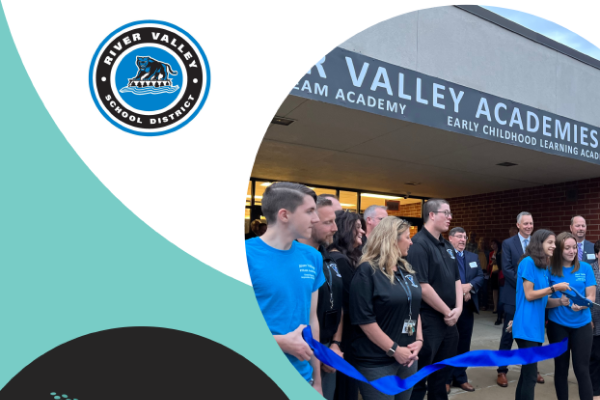Starting Young to Spark Student Growth, Family Engagement
May 01, 2023
AASA Learning 2025 Lighthouse Demonstration System: WEST VALLEY SCHOOL DISTRICT
Educators would agree that having students enter the public school system ready to learn is a basic foundation for student success.

In Washington’s West Valley School District 208, a fierce focus on early learning as the defining characteristic determines where the district directs its resources.
West Valley, enrolling about 5,000 students in preK through 12, encompasses suburban and rural areas outside Yakima, Wash., near the Cascade Mountains. About 50 percent of the students qualify for free or reduced-price meals and 8 percent are English language learners. The overall demographic breakdown is 55 percent white, 37 percent Latino and 8 percent other groups.
Launched in fall 2011, the West Valley PreK Initiative encompasses more than just what happens with young students in their classroom. It’s a major part of why West Valley has been designated an AASA Lighthouse district.
“The research is clear,” says West Valley’s superintendent, Peter Finch, who has led the district since 2021 and worked in the district for more than 20 years. “A focus on early learning makes a difference for a child’s success.”
Home Visits
In West Valley’s approach, Finch explains, there’s an expansive view of early learning that translates into several component programs. Some are programs operated within the district, with 20 community organizations also involved in partnerships.
The P-3 Leadership Team, meeting monthly, includes school staff members and others who work in childcare centers, state and federally funded preschools, faith-based preschools and the educational service district serving the region.
The idea behind this leadership team and its meetings with wide inclusion is to be sure the organizations that are feeders for West Valley’s schools are aligned with curriculum goals, instruction, assessment, professional development and parent engagement.
“One of the things that stands out is home visiting,” Finch says. Since 2001, a home-visit program prepares 3- and 4-year-olds for kindergarten.
Another key program, which runs every Friday, is the “play and learn” group at each elementary school. Bilingual staff provide another way to reduce barriers. During these sessions, parents can learn about available child development and community resources while the children are engaged in focused activities.
The same staff members handle the home visits with families twice a week, a way to promote continuity and build relationships.
“This is about strengthening families with social connections, brings families in, and is part of building community,” Finch says. “School is the community hub.”
Outreach Impact
For Michael Marshall, a kindergarten teacher at Cottonwood Elementary School, the impact of the district’s outreach efforts is apparent to educators. After a visit to the home of an incoming kindergarten student who was enrolled in one of the district’s preK programs, Marshall says, ”she knew I was her teacher” and from “day one in school, she’s more excited and more comfortable. It’s building that relationship and familiarity.”
During the COVID-19 shutdown of in-person schooling, West Valley offered support sessions on Zoom in English and Spanish to help families who were dealing with food insecurity and mental health needs because of the isolation.
Another program that Finch cites is the work done with the WaKIDS (Washington Kindergarten Inventory of Developing Skills) to identify children’s readiness for kindergarten and to offer interventions if needed.
“We can focus on those students who have higher needs,” he says.
Since the district began its focus on kindergarten readiness, the data have been encouraging. In 2015, only 38 percent of incoming students were deemed ready for kindergarten, while last fall, 60 percent of incoming students were developmentally ready.
Other results reflect the effectiveness of West Valley’s initiative. Two-thirds of the district’s 3rd graders met the standard in English language arts in 2018, compared to 56 percent across the state. Testing after the pandemic lockdown showed 56 percent of West Valley 3rd graders met the English standards, compared to the state’s 47 percent.
Parental Learning
Similarly, says Minerva Pardo, the family and community engagement coordinator for West Valley, much of her focus is helping parents who grew up elsewhere understand the American education system so they can better support their children.
“We try to build that bridge,” she says. “Many don’t trust the system, and that doesn’t help them engage with the schools.”
For example, those who’ve emigrated from Mexico may not understand that learning language skills in the United States is more than copying letters of the alphabet, Pardo says. The district offers separate Spanish-language sessions to provide families with a supportive environment. Pardo and her team facilitate ways for parents to complete their own elementary and high school education and guide them through the system. Some even ask her for contact information for an immigration attorney.
“We can link them to services and can provide support to parents,” Pardo says.
She adds, “The first step to removing barriers — language, cultural, socio-economic needs even before their children enter schools — is to have something ready for them when they start school. What’s important is to help these parents know they have the tools.”
The work and investment the district makes in students even before they officially enter the system is seen as part of a continuum, Finch says. “It’s a K-3 continuum, with a focus on students meeting standards for reading by 3rd grade.”
MERRI ROSENBERG is a freelance education writer in Ardsley, N.Y.
Author
Roster of Lighthouses
To read the full list of Lighthouse school systems being featured in this series and learn more about becoming a demonstration district, visit aasa.org/learning2025.
Advertisement
Advertisement
Advertisement
Advertisement




